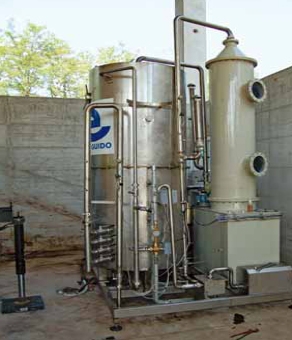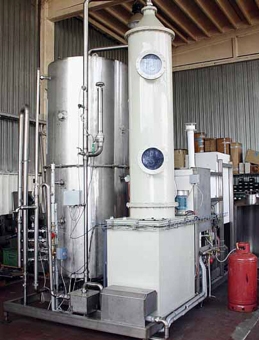Stripping

The current techniques used to reduce the nitrogen content in the dejections are essentially based on two different types of intervention: the first is the reduction of the proteic nitrogen in the diet; the second is based on the nitrogen reduction in the dejections obtained with the installation of technologies for the treatment of the dejections before its use in agricolture.
The treatments, both physics and mechanics, such as the separation solid-liquid, and biological, being them aeration processes or processes based on nitro-denitro (with active muds in traditional reactors or in the same reactor with Sequencial batch reactor technology), allow a higher or lower reduction of the nitrogen content in the liquid dejections, but in return they cause the loss of part of the element in the atmosphere as ammonia.
DESCRIPTION OF THE PROCESS
The liquid fraction coming from the separation, after the clarification, is heated and continously thrown in the tank for a pH correction before being conveyed to the section of the ammonia treatment. It is important to note how the stripping and absorbing phases operates in a closed cycle for the gaseous flow, to avoid all the concerns about the gaseous emissions in the air.
The ammonia, removed from the liquid phase and transferred to the gaseous phase in the stripping, is then absorbed (in acid solution) before the next use in the stripping tower. The biphase contact between the liquid phase containing ammonia and the stripping air is carried out in a column with filling bodies, with quite high operating temperatures: therefore the column has to work in isothermical conditions of about 55 °C.
The specific building features grants the constant temperature and the flows of liquid and gas in each section of the tower. To reduce at a minimum the consumption of thermal energy, the clarified digestate is preheated in a heat exchanger in countercurrent with the waste going out from the bottom of the stripper. A second heater from the cogeneration group brings the waste's temperature at its ideal value, while the isothermal of the column is granted by special patented plants disposition.
The exchangers are equipped with an automatic cleaning system controller by PLC.
The waste, dripping along the stripping column, transfers the ammonia in countercurrent at the gas flow. The ammonia air going out from the lenght of the stripper is sucked by a special fan and sent to the base of the absorbment column. In the column, with filling rings, the ammonial air is taken from a sulphuric acid flow feeded by a booster pump.
The sulphuric acid acts with the ammonia included in the air salifying it to ammonium sulphate, up to a prefigured pH value.
When the pH value is reached, the ammonium sulphate reaches the prefigured pH value, this is automatically extracted and the absorber is charged with fresh sulphuric acid.
The air deprived by ammonia, is then recicled at the base of the stripping, so to stay in a closed circuit and to avoid the immission in the atmosphere.
The waste going out from the bottom of the stripping column, cooled by a regeneration exchanger in countercurrent for the pre-heating of the waste in entry which has to be treated, and then it is sent to the storage tanks for its next use in agriculture.
THE AMMONIC SULFATE COLLECTED IN SPECIAL TANKS, CAN BE SOLD FREELY AT THE MINIMUM TITLE OF 6% OF NITROGEN. (according to Decree n. 217 of 29/april/2006).
Semplified block diagram for the nitrogen reduction
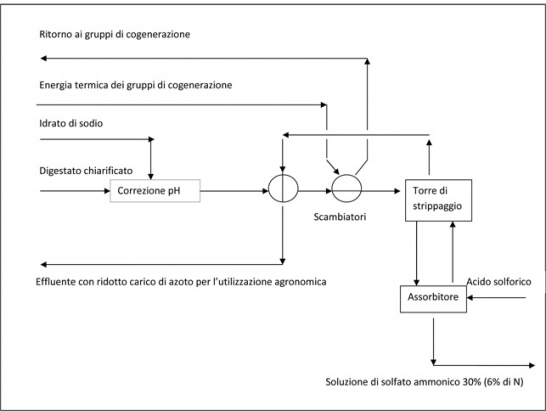
"Innovative system for the treatment of zootechnical liquid dejections, for the energetic and water saving, the reduction of the inflluences on the environment and the achievement of high-quality products."
Within the project, ROTA GUIDO company has carried out together with CRPA the experimental theory test on the efficiency of the removal of nitrogen from cows' liquid dejections, both subjected or not to treatments of anaerobic digestion, using a hot-stripping plant and the thermical and electrical energy coming from the energetic use of the biogas produced with the anaerobic digestion.
This project is included in the measure 3.1 A – PRRITT of the region Emilia Romagna (Notice February 2004).
The reduction of the nitrogen level in the zootechnical affluent throug the technique of stripping by air blowing, provides the passage of the ammonia which is present in the liquid, in an acid solution so to produce a stable sal ammoniac. To improve the handling of the sal ammoniac, the treatment can be pushed up to the production of granulated sal. The quantity of ammonial nitrogen that can be stripped from the liquid or absorbed by an acid solution, depends on two
technical balances:
1) Balance of the ammonial ion in air and water
2) Dissociation balance of the ammonia in solution
Anyway, the higher the pH and temperature, the bigger is the fraction of free ammonia.
The activities had the aim to experiment, first of all, the process and the efficiency of stripping and, in a second time, to analyze the problem of the handling of watery solutions of sal ammoniac obtained from scrubber and coming from the
acid washing in the stripping area. The experimental stripping activity has been carried out at farm Boldini located in Basilicanova – Montechiarugolo (PR).
The main activity of the farm is the breeding of milking cows.
The animals in the farm are about 300. The liquid dejections are transferred in a stripping/separation station. The solid part is used as fertilizers on the soils, while the liquid part feeds the plug-flow digestor. Then the digestate coming out from the biogas plant has been conveyed to the experimental plant installed in the farm.
Layout of the prototype of the stripping reactor with scrubber and instrumentation for the experimental monitoring.
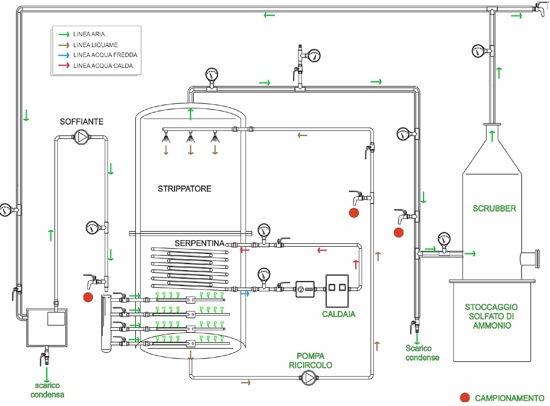
The main parameters monitored during each test are the following:
1) chemical characteristics of the liquid manure (pH and ammonia nitrogen): at the beginning of test and at each working hour
2) chemical characteristics of the liquid manure (pH, total solids, total nitrogen and ammonia nitrogen): at the beginning of the test and at the end of the proof;
3) air temperature in various points of the plant: the upper and the bottom of the reactor, inside the liquid manure in the reactor, the upper and the bottom of the scrubber and in the hot water circuit for the reactor's heating;
4) pression at the upper and bottom part of the stripping reactor;
5) concentration of ammonia nitrogen in the air flow used for the stripping in the upper and lower part of the stripper and in the upper and bottom part of the scrubber;
6) nitrogen concentration and volume of the ammonia sulphate in the scrubber's tank;
7) electric consumptions: a network analyser and an hour counter has been installed for each of the different components of the prototype;
8) thermical consumptions: the heating of the liquid manure at the beginning of the test and the mainteinance's consumptions during th einsufflation have been monitored by weighing each hour the GPL gas cylinder used for the boiler's feeding.
Picture: point of liquid manure's sampling
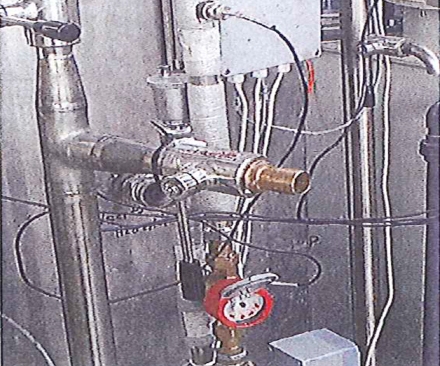
To reach the meaning of the experiment, also the cows' liquid manure as it is from the stables has been put to the stripping test.
The results are shown in the following tables:

Chemical-physic characteristics of the liquid before the anaerobic digestion and of the digestate before and after the stripping treatment.

Variation of the chemical-physic parameter of the treated liquid and reduction of the ammonia nitrogen content in the two thesis.
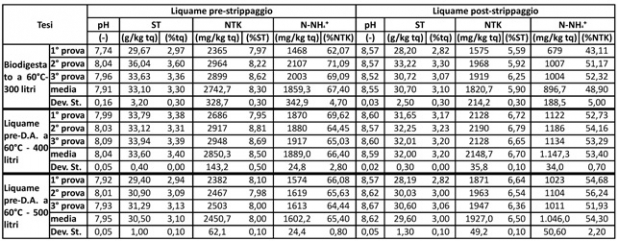
Chemical-physical characteristics of the liquid before and after the stripping treatment at the varying of the quantity of liquid loaded in the stripper.
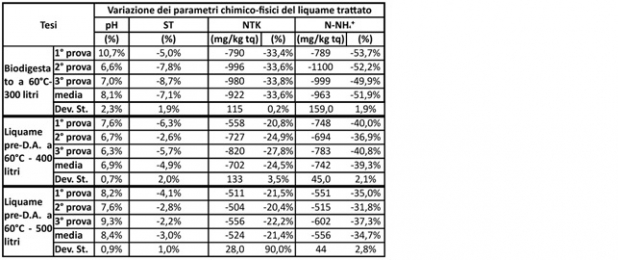
Variation of the chemical-physical parameter of the liquid and reduction of the ammonia nitrogen content at the varying of the liquid loaded in the stripper.
The datas taken from the tables show remarkable percentages of nitrogen reduction.
The energetic consumption above reported is referred to the proof made with pilot reactor, where the stripping, for experimental reasons, has not taken place in continous and where the energetical efficiency can be considerably improved by passing to devices on industrial scale and not on small pilot reactors.
It is obviously to be reminded that the product of the stripping, that is the ammonia sulphate, can be interely used in the mineral fertilization in agriculture.
